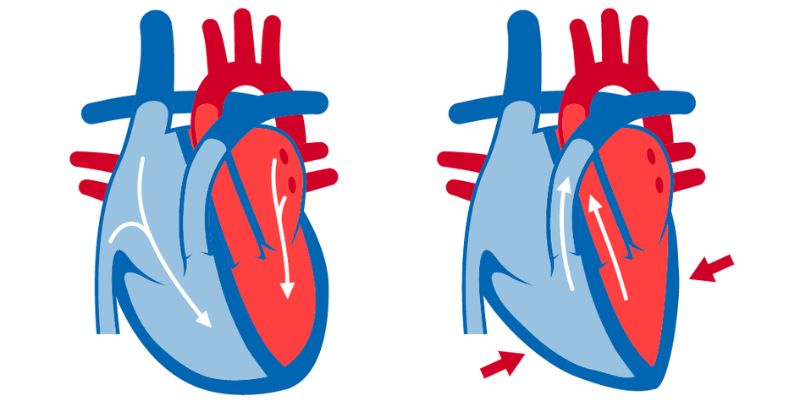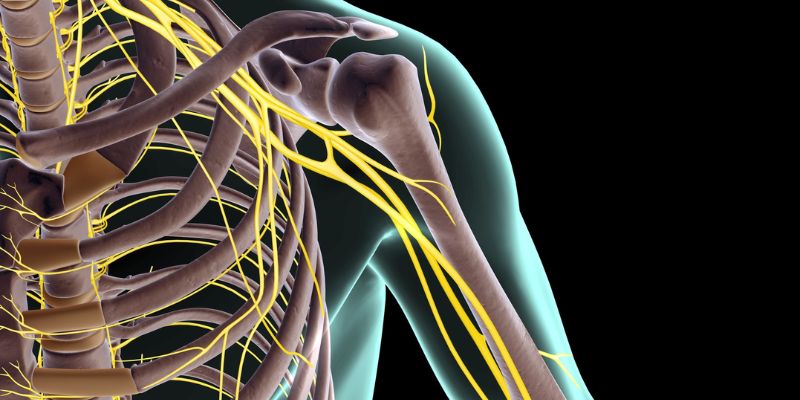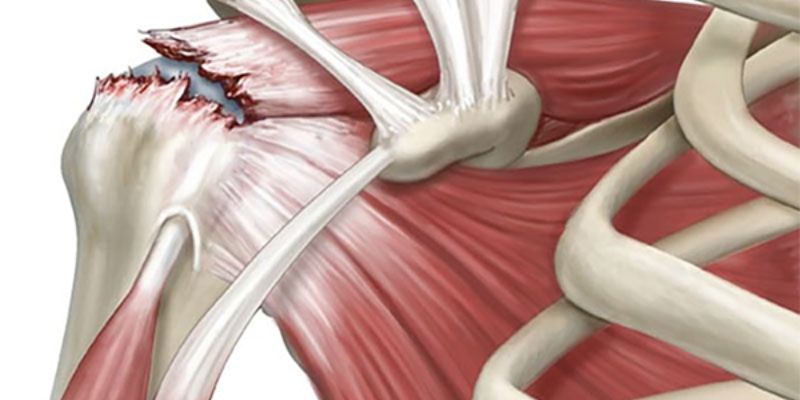
Are you experiencing shoulder pain? If so, you may have rotator cuff pain. This shoulder-related injury can occur from many activities, including sports or everyday activities such as lifting an object above your head.
If left untreated, rotator cuff problems can be very painful and lead to long-term damage in the shoulder area. Therefore, if you are struggling with shoulder pain, you must learn more about this issue and find ways to treat and prevent further discomfort.
In this blog post, we will discuss what rotator cuff injury is all about; its types, causes, symptoms, and how to address them properly. So read on to uncover more facts related to rotator cuff safety today!
Rotator Cuff Pain
Rotator cuff pain is a common shoulder injury, typically caused by repetitive movement or wear and tear. It occurs when the tendons in the rotator cuff muscles become inflamed, torn, or worn down.
The rotator cuff consists of four muscles that connect to your shoulder blade (scapula) and upper arm bone (humerus). Pain associated with this condition can be felt at the front and side of your shoulder and upper arm.
Rotator Cuff Pain Symptoms
Rotator cuff pain is a common injury that can cause significant discomfort and long-term damage if left untreated. It can occur from many activities, including sports or everyday activities like lifting an object above the head. Although there may be some overlap, the indications of rotator cuff pain depend on the individual etiology.
Sharp Pain and Swelling
Sharp or aching pain and swelling over the front or outside (lateral) part of the shoulder and upper arm are two of the most common symptoms of rotator cuff injury. This symptom is usually due to tendinitis or a rotator cuff tear. In some cases, the pain can also be felt farther down the arm.
Difficulty Performing Activities
People with a rotator cuff injury may experience difficulty performing everyday activities, such as combing their hair or reaching behind their backs. These activities can be more difficult due to the pain and lack of strength in the affected arm.
Loss of Strength
In addition to pain, those suffering from a rotator cuff tear may experience a loss of strength in the arm. This can make it hard for people to put away dishes in upper cabinets or reach into refrigerators to lift heavier objects.
Pain When Sleeping
With rotator cuff tendonitis or a tear, nighttime throbbing discomfort is also typical. The shoulder pain brought on by this injury may even lead people to wake up in the middle of the night.
No Pain
In some cases, people with rotator cuff tears do not have any pain. Moreover, more severe tears can sometimes cause less pain than partial tears. Rotator cuff tendinosis does not cause pain either, especially early on.
When to See a Healthcare Provider
• If you have severe shoulder pain that comes on suddenly.
• Swelling, bruising, redness, or warmth around the shoulder joint.
• Shoulder pain that is persistent or worsening.
• Trouble breathing, dizziness, or abdominal pain along with shoulder pain.
• Difficulty lifting your arm above your head or carrying objects.
• Any trauma or injury to the shoulder, especially if it looks deformed.
Causes
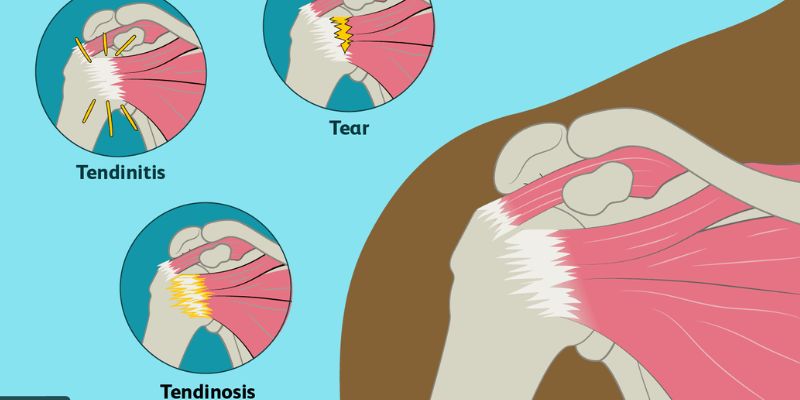
There are three main causes of rotator cuff pain:
Rotator Cuff Tendinitis
Rotator cuff tendinitis is the most common cause of rotator cuff pain in young athletes and middle-aged adults.
It occurs when the normal, healthy tendon becomes inflamed or injured due to overuse of the muscles involved in overhead reaching motions or throwing activities such as tennis, swimming, baseball, volleyball, and weightlifting.
Moreover, certain chronic diseases such as diabetes and obesity can also increase the likelihood of developing tendinitis.
Rotator Cuff Tear
A rotator cuff tear is a much more serious injury and usually occurs in middle-aged or older adults. It is caused by trauma like a fall or blow to the shoulder and from overuse of the rotator cuff muscles. Additionally, factors like obesity and smoking can make an individual more prone to tearing their rotator cuff tendon.
Rotator Cuff Tendinosis
Finally, rotator cuff tendinosis is a condition in which the tendons weaken due to aging caused by decreased blood supply. These weakened tendons are likelier to tear or inflamed due to smoking, poor posture, repetitive overhead activity, and genes.
Diagnosing Rotator Cuff Pain
Empty Can Test
The empty can test is a simple physical exam that checks for supraspinatus damage, which is located on the upper part of the shoulder.
To do this test, you need someone's help, as you must lift your arm out parallel to the floor and turn it so that your thumb points toward the ground (as if trying to dump out a soda can). If pain or weakness prevents you from keeping your arm in this position, you may have a supraspinatus rotator cuff injury.
Lift-Off Test
The lift-off test is a shoulder test to determine if you have a tear in the subscapularis muscle, located on the underside of your shoulder blade and responsible for rotating the shoulder inward.
Resistance Testing
To do this, sit comfortably in a chair and have someone push your hand toward your belly while you bend your elbow 90 degrees and keep your elbow tucked into the side. If you experience difficulty or pain holding this position, it may indicate a rotator cuff tear.
Pain-Relief Test
A doctor will inject lidocaine, an anesthetic that numbs the area, into your shoulder joint. If you have a rotator cuff tear, the pain will be relieved, but the muscle will remain weak. If you have rotator cuff tendinitis, the lidocaine will relieve the pain, and your muscle strength will remain normal.
Imaging
If your provider suspects that you may have a rotator cuff tear, they may recommend an imaging test such as an MRI or arthrogram to see if there is evidence of a tear or any other shoulder problems. An ultrasound can also be used to check for signs of a rotator cuff injury.
Differential Diagnoses
To accurately diagnose rotator cuff pain, do
doctors must rule out other possible causes of symptoms like biceps tendonitis, labral tear, frozen shoulder, osteoarthritis, and shoulder instability or dislocation. Imaging tests such as X-rays can show signs of osteoarthritis, while an MRI can detect a labral tear.
Blood tests and ECG/EKG can rule out heart conditions that may cause shoulder pain in the rotator cuff region.
Treating Rotator Cuff Pain
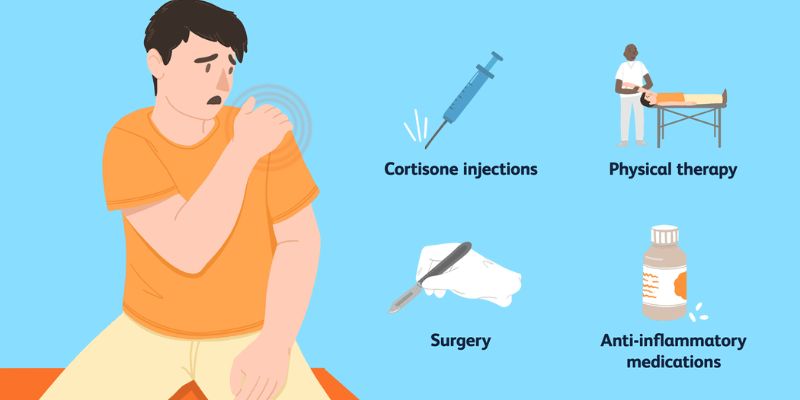
Treating rotator cuff pain depends on the type and severity of your injury. Generally, conservative treatments such as rest, medications, physical therapy, and exercises effectively relieve pain.
Rest
Medical professionals often recommend resting to help relieve discomfort from a rotator cuff injury. Take frequent breaks throughout the day and avoid activities aggravating your shoulder area.
Medications
Over-the-counter nonsteroidal anti-inflammatory drugs (NSAIDs) are often prescribed to help with the pain and swelling associated with rotator cuff injuries. In addition, topical medications or corticosteroid injections may be administered to reduce inflammation in the area.
Physical Therapy
Physical therapy is a key component of treating a rotator cuff injury. During physical therapy sessions, your therapist will teach you exercises designed to strengthen the muscles and ligaments around the shoulder area. This helps to improve mobility and reduce pain.
Surgery
In some cases, surgery may be necessary for serious rotator cuff injuries. Surgery aims to repair any torn tendons or muscles in the shoulder area and restore function as much as possible. Recovery from surgery can take several months, but following your doctor's instructions is important to achieve the best possible outcome.
FAQs
What are 2 warning signs of a rotator cuff tear?
The two warning signs of a rotator cuff tear are difficulty lifting the arm above your head or carrying objects and pain or weakness in the shoulder.
How do I prevent rotator cuff injury?
To prevent rotator cuff injury, it is important to stay physically active and maintain good posture; avoid repetitive overhead activities such as throwing a ball; use proper form while exercising; take regular breaks when engaging in activities that require the use of the shoulder muscles; and strengthen the shoulder muscles with exercises designed for this purpose.
Where do you feel rotator cuff pain at?
Rotator cuff pain is typically felt outside the shoulder area and can radiate down the arm.
Conclusion
The rotator cuff is a common shoulder-related injury that can greatly affect the quality of life. It is important to recognize the warning signs and take steps to prevent or treat an injury if it occurs. If you are experiencing persistent pain in your shoulder, it is best to consult with a medical professional who can advise on the best course of action.
